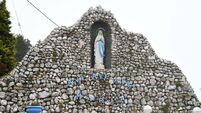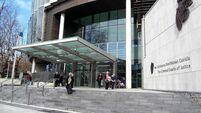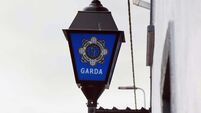Our cultural heritage is under siege by bureaucratic barbarians at the gate
In a plot line straight out of Father Ted, a number of councillors in Athlone have reacted with horror to a large installation by artist Shane Cullen, which painstakingly reproduces the messages of hunger-striking Republican prisoners that were smuggled out of the infamous H-Block prison in 1981.
However, instead of picketing the gallery with signs screaming “down with this sort of thing” or “careful now”, Fine Gael Councillor Mark Cooney opted to put down a motion at Monday’s local authority meeting calling for the art work to be removed.
According to reports from the Westmeath Independent, Mr Cooney began his diatribe by comparing the piece to Nazi propaganda, apparently unaware of Godwin’s Law, which states that the first person to invoke Hitler in a debate loses the argument. Ploughing on regardless, the Fine Gael councillor reluctantly conceded that the installation had some degree of artistic merit, but nevertheless called for its removal from the gallery because it had caused offence to so many people, not least his father, former Justice Minister Paddy Cooney.
Strangely, Mr Cooney’s claim of widespread outrage in the town didn’t chime with reports from the gallery, which said that out of 1,200 visitors to the exhibition by Monday, just three had complained about the piece. “We need censorship to protect our children — sometimes you have to do it,” insisted the councillor, whose next crusade will, presumably, be the censorship of history books to expunge the details that he finds objectionable.
Supporting the motion, fellow Fine Gael councillor Gabrielle McFadden, whose sister Nicky is a TD for the area, stated that publicly funded art galleries shouldn’t display politically contentious art — which, on reflection, means that, in this country at least, no art with a political element could ever be displayed in case it upsets someone.
One assumes that Ms McFadden will next be writing to Madrid’s Reina Sofia museum and advising that Picasso’s masterpiece, Guernica, be removed from its walls lest it offend local fascists. According to Mr Cooney and Ms McFadden, art is not something that challenges or provokes but instead should be pretty and pedestrian.
Disappointingly, instead of roundly condemning these politicians’ efforts to act as the final arbiter for what constitutes “proper” art, a majority of the council opted to indulge their boorish arrogance and forward the motion to the board of the gallery for its consideration.
Hopefully, the attitude of one board member, Michael McDonnell, who told RTÉ news that he was “dumbfounded” by the “ridiculous” motion, is reflective of a majority sentiment and the request will be unceremoniously rejected when it comes before it next week.
Mr Cullen, for his part, has expressed his shock at the brazen attempt to censor his work, which was purchased by the Irish Museum of Modern Art in 2000, saying that, in the 15 years since he created it, it has been exhibited all over the world, including in Northern Ireland.
“There were objections to the piece being shown [in Portadown], but there was no question of it being removed from a gallery space or censored in any way.
“You can show the piece in San Francisco, New York, Paris... there’s a respect for the autonomy of the artist, and people involved in the arts, in these countries that sadly seems to be lacking here,” he said.
While certain members of Athlone town council can congratulate themselves on turning the local authority into a national laughing stock, and proving the case for the abolition of town councils, the imminent risk of a widespread threat to artistic autonomy is a real concern.
Minister for Arts, Heritage and the Gaeltacht, Jimmy Dennihan, has this week confirmed that he is determined to forge ahead with plans to merge the boards of the National Library and the National Museum. As part of the plans, the independent boards of both institutions will be abolished and a new nine-member advisory council, operating within the department, will be established.
This retrograde step will strip away the autonomy and independence that the boards of both hugely important cultural institutions currently enjoy and raises the spectre of political interference in their day-to-day operation.
The chairman of the board of the National Museum, John O’Mahony, has described the merger as “cultural cannibalism” while historian Diarmuid Ferriter, who resigned from the board of the National Library in May in protest at the plans, has warned, “the bureaucratic barbarians are at the gate”.
While some dismissed these concerns as self-interested hyperbole from artistic luvvies, the events in Athlone this week confirm that they are, in fact, legitimate fears. If the board of the Luan Gallery was not independent of the council that funds it, then Mr Cullen’s artwork could now be packed into boxes and awaiting transportation back to IMMA in Dublin. The protestations of Mr Deenihan, that his department would never presume to interfere in the artistic endeavours of cultural institutions, do not stand up to much scrutiny when elected members of his own party have this week attempted to do just that.
DEFENDING the plans, the Minister has said his reforms will accrue annual savings of €1m, in part because of the amalgamation of the boards and the elimination of board membership fees, but, as members of both boards are now working pro bono, it is hard to see where these specific savings will arise.
It is also difficult to see how just one board, with such a limited membership, can possibly be best placed to competently run the affairs of two such large and divergent artistic institutions.
While the minister has trumpeted the plans as a major reform, the consensus of academics and artists is that the merger is a regressive step back to a discredited administrative structure that previously operated before 1997, when the National Cultural Institutions Act severed the running of the institutions from the department and facilitated the creation of independent boards
Furthermore, despite the minister’s insistence that a particular focus of the new advisory council will be on securing philanthropic investment, it will be difficult for a state board, devoid of the niche expertise of its independent forerunners, to approach investors and convince them that they, and not the state controlling the institutions, should fund their work.
The minister may be well intentioned, but he should listen to the cacophony of complaints from experts working in the area and reconsider his plans, which should be deeply concerning to anyone who values the preservation of our cultural heritage, before it’s too late.
This Government has used the pretext of austerity to introduce many regressive and self-serving measures but our cultural institutions, which act as a custodian of history for future generations, should be impervious to experimental meddling, particularly when the stated savings are so paltry.














